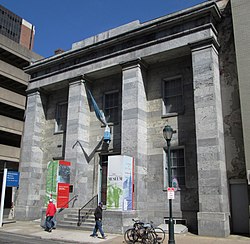Philadelphia History Museum
Franklin Institute | |
U.S. National Register of Historic Places | |
 (2013) | |
 | |
| Location | 15 S. 7th St. Philadelphia, Pennsylvania |
|---|---|
| Coordinates | 39°57′1″N 75°9′9″W / 39.95028°N 75.15250°WCoordinates: 39°57′1″N 75°9′9″W / 39.95028°N 75.15250°W |
| Built | 1825 |
| Architect | John Haviland |
| Architectural style | Greek Revival |
| NRHP reference No. | 79002319[1] |
| Added to NRHP | August 1, 1979 |
The Philadelphia History Museum at the Atwater Kent was a public history museum located in Center City, Philadelphia from 1938 until 2018. The museum occupied architect John Haviland's landmark Greek Revival structure built in 1824–1826 for the Franklin Institute.[2] The Museum operated as a city agency as part of Philadelphia's Department of Recreation. The building was listed on the National Register of Historic Places on August 1, 1979.[1]
History[]
The museum was established through the efforts of Philadelphia Mayor S. Davis Wilson, , president of the Philadelphia Society for the Preservation of Landmarks, and A. Atwater Kent, radio pioneer and inventor. In 1938 Kent purchased the former Franklin Institute building, which the Institute had vacated in 1933,[3] and gifted the building to the city for use as a public history museum. Following renovations carried out by the Works Progress Administration, the Museum opened in 1941. [4]
After years of declining attendance and financial shortfalls, the museum closed its doors in 2018. [5] In September 2019, the city approved a plan to transfer the museum's collections to Drexel University. [6]
Collection[]
The Museum's collections included more than 80,000 objects related to Philadelphia and regional history, including an estimated 10,000 17th- to 20th-century artifacts from the Historical Society of Pennsylvania art and artifact collection, 1700 Quaker-related items from Friends Historical Association Collection, and collections reflecting Philadelphia manufacturing, the 1876 Centennial Exposition, toys and miniatures, and radio broadcasting.[7]
Highlights from the permanent exhibitions included the boxing gloves of Joe Frazier,[8] the desk of George Washington,[9] a drinking glass owned by Benjamin Franklin,[8] and a wampum belt allegedly given to William Penn by the Lenape.[9]
See also[]
 Philadelphia portal
Philadelphia portal
References[]
Notes
- ^ Jump up to: a b "National Register Information System". National Register of Historic Places. National Park Service. January 23, 2007.
- ^ "Museum History — Philadelphia History Museum". www.philadelphiahistory.org. Retrieved 2017-07-15.
- ^ Gallery, John Andrew, ed. (2004), Philadelphia Architecture: A Guide to the City (2nd ed.), Philadelphia: Foundation for Architecture, ISBN 0962290815, p.36
- ^ "Museum History — Philadelphia History Museum". www.philadelphiahistory.org. Retrieved 2017-07-15.
- ^ "Philadelphia History Museum Shuts its Doors Indefinitely". Retrieved 2021-03-06.
- ^ "Drexel is Prepared to Take Charge of Philadelphia History Museum holdings". Retrieved 2021-03-06.
- ^ "Museum History — Philadelphia History Museum". www.philadelphiahistory.org. Retrieved 2017-07-15.
- ^ Jump up to: a b "Philadelphia History Museum at the Atwater Kent". Retrieved 2017-07-15.
- ^ Jump up to: a b "Special Collections — Philadelphia History Museum". www.philadelphiahistory.org. Retrieved 2017-07-15.
Bibliography
- Weigley, et al. Philadelphia: A 300 Year History. New York: W.W. Norton, 1982.
External links[]
| Wikimedia Commons has media related to Philadelphia History Museum. |
- Official website
- Virtual Tour of Philadelphia's stop at the Atwater Kent
- Philadelphia department of recreation
- Building listing, photograph, and drawings at the Historic American Buildings Survey
- Building listing, history, and images at Philadelphia Architects and Buildings
- Museums in Philadelphia
- City museums in the United States
- History museums in Pennsylvania
- National Register of Historic Places in Philadelphia
- Museums established in 1938
- Works Progress Administration in Pennsylvania
- Market East, Philadelphia
- 1938 establishments in Pennsylvania
- Greek Revival architecture in Pennsylvania
- Cultural infrastructure completed in 1825
- John Haviland buildings
- Defunct museums




